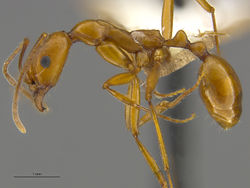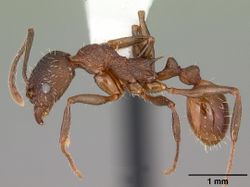Key to US Aphaenogaster species
This key to the workers of Aphaenogaster of the United States is based on Creighton (1950), Umphrey (1996), Mackay and Mackay (2002) and unpublished notes by Bill Mackay. See also the key provided by DeMarco (2015) - below.
1
- Propodeal spines lacking, or simply represented by small bumps or carinae => 2
- Propodeal spines present, although may be small or in the form of ridged teeth => 5
2
return to couplet #1
- Base of the antennal scape with a small lobe which projects anteriorly; node of the petiole longitudinally oval when seen from above and scarcely wider than its posterior peduncle => Aphaenogaster floridana
- Base of the antennal scape without a lobe; node of the petiole almost circular when seen from above and distinctly wider than its posterior peduncle => 3
3
return to couplet #2
- Eye very large, strongly protuberant, with 18 to 20 facets in its greatest diameter, its lower border approximately the greatest ocular diameter from the mandibular articulation; body a sorbid, pale, yellowish tan => Aphaenogaster megommata
- Eye notably smaller, with about 15 facets in its greatest diameter, its lower border about 1½ times the greatest ocular diameter from the mandibular articulation; head and mesosoma ferrugineous red => 4
4
return to couplet #3
- Gaster black or darker than mesosoma => Aphaenogaster smithi
- Gaster brown or nearly concolorous with mesosoma => Aphaenogaster boulderensis
5
return to couplet #1
- Antennal scape with a conspicuous lobe which extends rearward along the basal fourth or fifth of the scape => 6
- Antennal scape without a basal lobe or, if a small lobe is present, it projects forward and does not involve the basal fifth of scape => 7
6
return to couplet #5
- Lobe of scape, seen from side, flat and thin, its length usually not more than one-fifth length of scape => Aphaenogaster ashmeadi
- Lobe of scape, seen from side, thick, its upper face forming obtusely projecting angle in middle, its length usually one-fourth length of scape or longer => Aphaenogaster treatae
7
return to couplet #5
- Basal quarter of first gastric tergum with delicate striae which spread fan-wise from attachment of postpetiole => Aphaenogaster mariae
- Gaster without basal striae, or if present do not spread fan-wise and are limited to basal eighth of tergum => 8
8
return to couplet #7
- Outer face of frontal lobe bearing flange which projects rearward in form of tooth or process => Aphaenogaster lamellidens
- Outer face of frontal lobe without toothed flange => 9
9
return to couplet #8
- Postpetiole broader than long and sub oval in shape; propodeal spines longer than basal face of propodeum => Aphaenogaster tennesseensis
- Postpetiole as long as broad or longer than broad, globular or as truncated cone in shape; propodeal spines shorter than basal face of propodeum => 10
10
return to couplet #9
- Antennal scapes of larger workers (not always true of minimums) surpassing occipital margin by an amount equal to, or less than length of first 2 funicular joints => 11
- Antennal scapes of all workers surpassing occipital margin by amount greater than length of first 2 funicular joints => 13
11
return to couplet #10
- Mesopleuron at least in part smooth and shining => Aphaenogaster patruelis
- Mesopleuron heavily sculptured and opaque => 12
12
return to couplet #11
- Head with abundant, fine, punctato-rugose sculpture between longitudinal rugae; color castaneous brown to piceous brown => Aphaenogaster occidentalis
- Head with very feeble interrugal sculpture; head and thorax orange yellow, gaster deep brown => Aphaenogaster uinta
13
return to couplet #10
- Middle of the pronotum with very feeble sculpture, its surface strongly shining; propodeal spines very slender => Aphaenogaster flemingi
- Entire pronotum heavily shagreened or densely sculptured, its surface opaque or subopaque; propodeal spines not notably slender => 14
14
return to couplet #13
- Base of antennal scape with small, angular lobe which projects forward => Aphaenogaster huachucana
- Base of antennal scape without such a lobe => 15
15
return to couplet #14
- Legs exceptionally long for body size, usually with TL > 1.50 (likely not true for minims, but adjusting for head size, usually with TL > 0.28 + 1.2HW) (rare; restricted to desert regions of southern New Mexico, Arizona, and Texas; reddish brown; cephalic sculpture delicate for size) => Aphaenogaster punctaticeps
- Legs not exceptionally long for body size, almost always with TL < 1.50 (adjusting for head size, usually with TL < 0.28 + 1.2HW) => 16
16
return to couplet #15
- Anterior edge of mesonotum rising abruptly above adjacent portion of pronotum, transverse welt thus formed distinctly concave in middle (more so in medium-sized and larger workers); propodeal spines strongly directed upward => 17
- Mesonotum not abruptly elevated above pronotum or, if higher (A. picea), anterior edge does not form transverse welt; propodeal spines rarely as long as posterior face of propodeum and usually directed backward => 18
17
return to couplet #16
- Eyes relatively larger, maximum diameter twice maximum diameter of scape; propodeal spines at least as long as posterior face of the propodeum; common and widely distributed in mesic habitats => Aphaenogaster fulva
- Eyes small, maximum diameter only slightly greater than maximum diameter of scape; propodeal spines about ½ length of posterior face of propodeum; known only from Florida, occurring in xeric habitats => Aphaenogaster umphreyi
18
return to couplet #16
- Propodeal spines relatively short and legs relatively long, so that ISPL < -0.17 + 0.233TL (see figure below, symbol code N21b); range includes Texas to the mountains of southern Arizona but excludes eastern North America => Aphaenogaster texana
- Propodeal spines relatively longer or legs relatively shorter, so that ISPL > -0.17 + 0.233TL (see figure below, all symbol codes other than N21b); range includes eastern North America but likely excludes the southwestern United States from western Texas to the mountains of southern Arizona => Aphaenogaster carolinensis, Aphaenogaster miamiana, Aphaenogaster picea, Aphaenogaster rudis, Aphaenogaster texana nana, Aphaenogaster texana punctithorax
B.B. DeMarco Key
This key, provided by DeMarco (2015), uses characters from Creighton (1950) and Coovert (2005), including striae, frontal carina with rearward facing tooth, antennal scape shape, and color of last four antennal segments.
1
- Striae at base of first gastral tergite, arboreal species => Aphaenogaster mariae
- No striae on first gastral tergite, not arboreal => 2
2
return to couplet #1
3
return to couplet #2
- Gaster same color as head and mesosoma (Alabama, Florida, Georgia, Mississippi, North Carolina, South Carolina) => Aphaenogaster floridana
- Gaster darker than head and mesosoma (Arizona, California, Colorado, New Mexico, Mexico) => Aphaenogaster boulderensis
4
return to couplet #2
- No setae on mesosoma or metasoma, spines strongly curved back (wide range from Nebraska to northern Florida) => Aphaenogaster tennesseensis
- Setae on mesosoma and metasoma, spines straight, curved in or not strongly curved back => 5
5
return to couplet #4
6
return to couplet #5
- Lobe one-fifth the length of the scape (Alabama, Florida, Georgia, Louisiana, Mississippi, North Carolina, South Carolina, Tennessee) => Aphaenogaster ashmeadi
- Lobe one-fourth the length of scape (Florida, Illinois, Michigan, Missouri, Mississippi, North Carolina, Tennessee, Virginia) => Aphaenogaster treatae
7
return to couplet #5
- Color light yellow in color, large eyes (Arizona, California, Nevada) => Aphaenogaster megommata
- Color varies from light brown to piceous, eyes not large => 8
8
return to couplet #7
- Frontal carina with rearward-facing tooth (southeastern states) => Aphaenogaster lamellidens
- Frontal carina without rearward-facing tooth => 9
9
return to couplet #8
- Spines pointed upward from propodeum, anterior edge of pronotum above mesonotum => 10
- Spines angled back or reduced, anterior edge of pronotum equal to or below mesonotum => 11
10
return to couplet #9
- Eyes reduced, reduced hind tibial spurs (rare species, Florida, Alabama) => Aphaenogaster umphreyi
- Eyes normal size, normal hind tibial spurs (Alabama, Illinois, Minnesota Mississippi, North Carolina, New Jersey, Tennessee, Virginia, Wisconsin) => Aphaenogaster fulva
11
return to couplet #9
- Spines thin, head and mesonotum shiny, light brown in color (Florida, Louisiana, North Carolina, Mississippi) => Aphaenogaster flemingi
- Spines variable, head and mesonotum not shiny, color variable => 12
12
return to couplet #11
- Spine length less than or equal to diameter of propodeal spiracle => 13
- Spine length greater than diameter of spiracle => 15
13
return to couplet #12
- Body unicolorous brown to black, with lighter legs (California, Baja Sur (Mexico)) => Aphaenogaster patruelis
- Head and mesosoma light brown/tan, gaster dark => 14
14
return to couplet #13
- Head rounded (wider at occiput), clypeus notched (Baja Sur (Mexico)) => Aphaenogaster mutica
- Head rectangular, clypeus emarginate (California, Idaho, Nevada, Utah) => Aphaenogaster uinta
15
return to couplet #12
- Spine shape triangular, barely longer than width of propodeal spiracle Scape with small triangular extension at base (Arizona, New Mexico) => Aphaenogaster huachucana
- Spine shape not triangular, longer than width of spiracle => 16
16
return to couplet #14
- Head narrowed posteriorly into neck, with collar (rare, only known from Mexico) => Aphaenogaster mexicana
- Head not narrowed posteriorly => 17
17
return to couplet #16
- Last four antennal segments lighter in color (except some forms in Canada) (Northeast plus Georgia, North Carolina, Tennessee, and West Virginia at higher elevations) => Aphaenogaster picea
- Antenna unicolorous => 18
18
return to couplet #17
- Mesosoma with fine rugae (British Columbia (Canada), California, Colorado, Oregon, Utah, Washington, Wyoming) => Aphaenogaster occidentalis
- Mesosoma punctate or coarsely rugose => 19
19
return to couplet #18
- Dorsum of head with coarse rugae (Arkansas, Arizona, Missouri, New Mexico, Oklahoma, Texas) => Aphaenogaster texana
- Dorsum of head with fine rugae => 20
20
return to couplet #19
- Posterior border of head moderately pointed (rare species, found only in New Mexico) => Aphaenogaster punctaticeps
- Posterior border of head rounded to flattened => Aphaenogaster rudis broad sense => 21
21
return to couplet #20
- Propodeal spines curved slightly inward (dorsal view), coarse rugae on mesosoma (CAD intron absent) (Alabama, Florida, North Carolina) => Aphaenogaster miamiana form
- Propodeal spines straight, fine rugae or punctate on mesosoma => 22
22
return to couplet #21
- Light to medium brown (CAD intron absent) (North Carolina to Mississippi) => Aphaenogaster carolinensis form
- Medium to dark brown (CAD intron present) (widely distributed throughout East coast, from Georgia to Massachusetts and west to Minnesota) => Aphaenogaster rudis strict sense
References
- Creighton, W. S. 1950a. The ants of North America. Bulletin of the Museum of Comparative Zoology 104: 1-585.
- DeMarco, B.B. 2015. Phylogeny of North American Aphaenogaster species (Hymenoptera: Formicidae) reconstructed with morphological and DNA data. Ph.D. thesis, Michigan State University.
- Mackay, W.P. & Mackay, E.E. 2002. The Ants of New Mexico: 400 pp. Edwin Mellen Press, Lewiston, N.Y.
- Umphrey, G. J. 1996. Morphometric discrimination among sibling species in the fulva-rudis-texana complex of the ant genus Aphaenogaster (Hymenoptera: Formicidae). Can. J. Zool. 74: 528-559.








































